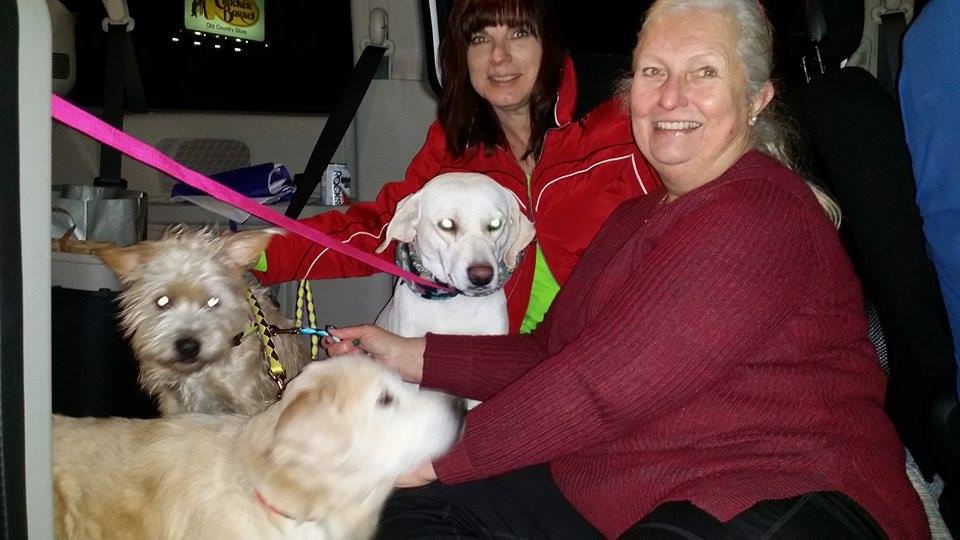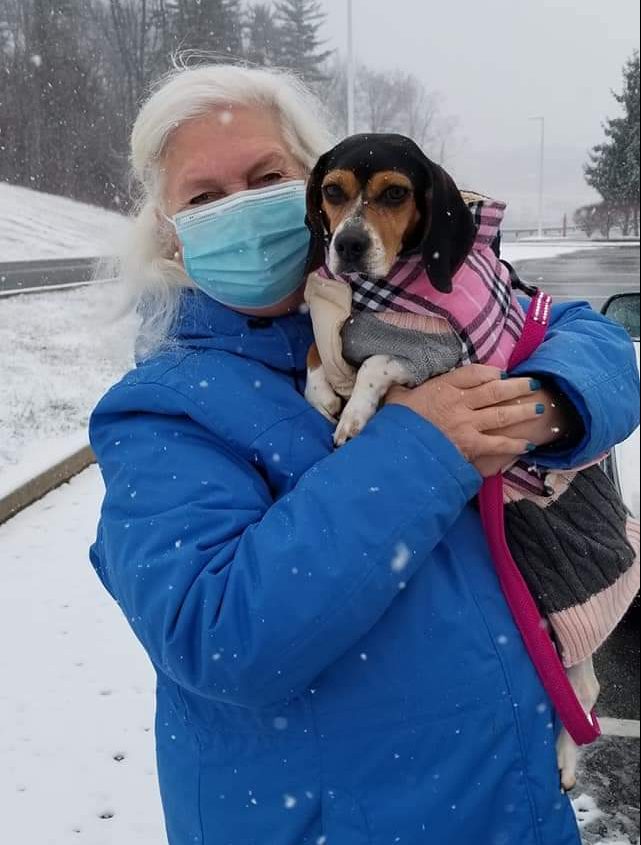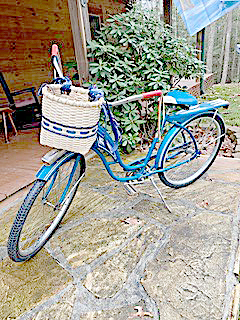By Sarah Richardson
“I’d say I’ve driven at least 1,000 dogs and I’ve been doing this for seven years,” said Susie Caldwell. “There was a husky that I got to hand over to her new owner, and we met down in Hart’s Run. The new owner drove here from Lexington to be on the last leg of the trip, and I actually got to see this lady hug her dog for the first time.”
Under the radar, massive groups are working to save lives and reunite families right under our noses and in plain sight. These groups are animal rescue transport organizations and the countless volunteers that make it possible.

A niche that many don’t think about, these transport groups focus on getting animals from one rescue to another, or to their foster homes, permanent homes, or reunited with their owners. Volunteers sacrifice their time, and offer to drive in stretches to get these animals from point A to point B.
One of these drivers is Caldwell, who lives in Lewisburg. An avid animal lover, she has four dogs of her own, a foster dog, and a cat.
Sometimes multiples times a month, Susie volunteers to drive the animals for sections of their journey, scheduling pickups with the leg before hers and drop-offs with the leg after hers. She also will keep dogs on overnight stays for “slumber paw-ties” until they can finish their trip.
“Sometimes it’s one night, sometimes it’s a week,” she said.
“I regularly check that West Virginia Transports Facebook page, and if I see they are coming past Lewisburg I think, ‘I’ll do leg number such-and-such, maybe Beckley to Lewisburg,’ and I’ll go to Beckley and come back, or, I’ll take a dog to Beckley to meet with the next leg. They are approximately an hour, an hour and fifteen legs each. Sometimes there are people who may have to go that direction anyhow, so they will do six legs. And they do. They will do as many legs as they can, and they want to. A lot of times they may bring their spouse or a friend with them.”
Locally, Susie estimates there are maybe a dozen or so other volunteers who participate in driving animals. “It seems like every time I go to meet somebody it’s like, ‘Oh! I didn’t know you transported,’” said Caldwell. “When I lived in Oklahoma City there were hundreds [of volunteers] out there.”
After she retired from nursing, Susan became a professional pet sitter. One day, on the group website for sitters, someone was reaching out looking for a driver to help with a transport.
“I thought, ‘Yeah, I could do that!’ and that’s how I got into this.”
While it’s mainly dogs that find themselves on these transports, it’s not unheard of to transport cats, pigs, and small mammals.
“I even transported a couple of goats one time,” Susie said.
When an animal ends up at a rescue for whatever reason, maybe they were abandoned, found as a stray, or were a runaway, the rescue will reach out to a transport group and fill out a transport application. Transport coordinators then work to schedule a multi-leg route to get the animal where it needs to be.
The coordinators then devise a runsheet with each leg listed in order along the route; post it to Facebook, and volunteers pick up the legs that they want to drive. There are a variety of Facebook pages that focus on finding drivers on a state-specific basis.
“Most of the time the legs fill up pretty quick,” Susie noted.
However, if there is a leg where nobody has offered to drive, the coordinators have lists of volunteer drivers all around the country who they will call to fill a gap.
“For example, they will have a list of people who live along I-64 in West Virginia,” said Susie. “They have the list of drivers along that route, and if they post a runsheet and people are not signing up for a certain leg then they will send an email or call and ask, ‘Hey, can you do this leg?’”

These transport organizations have headquarters all over the United States, and their coverage span covers coast to coast, and even overseas on some occasions.
“There’s Liberty Ride, she’s located in Montana but coordinates transports all over the United States. There’s also Kindred Hearts Transport Coordination (KHTC). Those are two really big ones, but there are so many others that are getting into this,” said Susie.
There is a fellow in Maine who mainly coordinates Pointer transports, another where a woman primarily focuses on Dachshunds, and many more that will work to coordinate a transport for any animal that needs a ride. These groups, combined with a strong volunteer driver force, ensure that no animal gets left behind.
Susie stresses the importance of microchipping your pets, as that’s a main way rescue facilities attempt to find a pet’s owner. One such case is an upcoming transport where a blue pit bull is traveling from California to Virginia to be reunited with their owner in a massive, multi-legged caveat involving a slew of volunteers across the nation.
“She got lost from her owner, broke out of her fence,” said Susie. “He looked and looked and looked, but he was [in the process of] moving to Portsmouth, Virginia. Because this dog had a microchip, when she was found they were able to scan it for a chip and called him to say they had found her.”
The finders submitted a transport request, which put the dog on the radar of the transport groups, who were quick to organize. Transport organizers came up with a plan that is roughly 30 legs long running from LA to Portsmouth to get this dog home.
“She will have some overnights along the way,” Susie added, as they try not to tax the dog by having too much transport time at once. At the end of each leg they also get a 10-minute reprieve and an opportunity to have a potty break and some water.
“A typical day for a dog in transport is maybe 12 hours,” she said. “With every stop we work in that 10 minute break for them.”
While this journey from California to Virginia is an exceptionally long one, a usual transport may run for a couple of days, typically starting on a Saturday morning and running through legs until Sunday afternoon or evening.
However, not all transported dogs are necessarily going straight to a new permanent home.
“A lot of times they may not be coming back to their forever home, and what we say is “fur”-ever home, but they’re coming to a foster home destination. That animal will live in the home and will be taught some daily manners, potty training, crate training as needed, socialization skills, and things like that.”
The foster home is also beneficial because it provides the opportunity to test how the animal is with different sorts of people, how they get along with other animals, and other placement factors.
“They do come to us with their vaccines up-to-date, that’s one of the rules,” said Susie. Along with having all their shots, transported animals have to complete a two-week-long quarantine, if they aren’t already spayed or neutered that is scheduled, if they are crossing state lines they have to get a medical certificate to stay in compliance with USDA guidelines, and more. The rescues perform this legwork, which is then verified by transport coordinators before the animal is cleared to start their trip.
But that’s not all the rules, the transporters themselves also have to follow a specific set of guidelines to keep themselves and the animals safe while on the road. All dogs must have two leashes, either one slip lead and a regular collar or a harness and a collar, and the dogs must be tethered in the car. Susie recommends a large carabineer to connect the leashes to the metal prongs of a car’s headrest. The reason for doing this is in the event of an accident, the dog remains secure in the vehicle.
Drivers also cannot leave the dog unattended in the vehicle for any length of time. Susie stresses the importance of having a bathroom break before trips for this exact reason, because if you drive alone you won’t get a break until you have passed the dog off to the next transporter.
There are special rules when it comes to transporting litters of puppies, Susie explained, since they are too young to be fully vaccinated. They must remain in a crate while in the vehicle, and during potty breaks there are no paws allowed on the ground (NPOG) so a sheet or tarp must be used.
On any given weekend, rain or shine, there are hundreds of these drivers out on the road working to get animals where they need to be. Without fanfare, volunteers like Susie change the lives of the animals they transport, as well as the lives of the people who end up reunited with or with a new four-legged family member.
If you would like to volunteer as a driver, please email news@mountainmessenger.com or call 304-647-5724.



